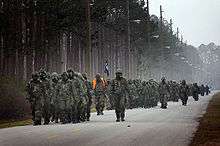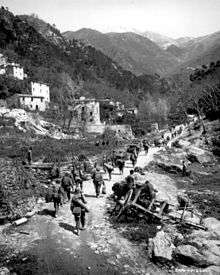Marching


Marching refers to the organized, uniformed, steady and rhythmic walking forward, usually associated with military troops.
Marching is often performed to march music, and often associated with military parades.
Marching is part of basic training in the military in most countries. In most cases, marching uses a system of drill commands. Learning to march by obeying commands is considered a form of discipline.
While marching, individuals must maintain their dress, cover, interval, and distance (DCID):
- dress — alignment with the person to the side;
- cover — alignment with the person in front;
- interval — space between the person(s) to the side;
- distance — space between the person in front.
In Northern Ireland, for some people, marching is a major provocative ritual. Hundreds of marches occur annually. These are usually organized by groups such as the Orange Order, which provide most of the participants. Music is provided by marching bands including silver bands, flute bands and others. Marching is often seen as a symbol of control over a particular area, and marching is often seen as a sectarian activity.[1]
The Royal Marines refer to a long distance march carrying full kit as a Yomp. The most famous yomp of recent times was during the 1982 Falklands War.
Military paces
In the military there are various military steps or standard paces. One step occurs on each beat. A pace is the length of one step (assumed to be 75 cm or 30"); do not confuse this use of "pace" with the ancient Roman unit of length (2 steps or 5 Roman feet = 148 cm or 58").
- Quick March: The basic mobility. 120 beats/min. In the USA this is called "quick time".
- Double March: The basic run. 180 beats/min. In the USA this is called "double time".
- Highland March: Regiment-specific pace, 80 beats/min. when wearing kilts.
- Rifles March: Regiment-specific pace, 140-beats/min. Like double-time, this is a rapid trot, with the rifle usually carried at the trail, not on the shoulder.
- Slow March: Ceremonial pace, 60 beats/min.
- Parade March: Usually seen combined with music, 120 beats/min. in the UK (except the Rifles who march at 140bpm), ~120 beats/min. in the USA and Russia
- French Foreign Legion Pace: 88 beats/min
- Paso Legionario: Specific march used by the Spanish Legion, 144 beats/min, embodiment of their "espíritu de marcha".
- Typical German speed is 112 bpm.
For mechanical efficiency, opposite arms usually swing with each leg while marching. British and Commonwealth armed forces keep their arms straight and swing the hand as high as the shoulder while forward and in theory to the level of the belt when backward. US Marines swing the arm six inches to the front and three inches to the rear while[2] US Army Soldiers swing the arm nine inches to the front and six inches to the rear.[3] Some European armies bend the arm during the swing. Most foot drill instructors believe these differing practices are efficient i.e. maintain rhythm for long route marches. US troops usually march long distances at "route step" which does not require them to maintain a specific pace or length of step. Some South American and Eastern European countries march on parade with the stiff leg earlier famous as the "goose step" of German troops. German and Scandinavian military bands and units swing with only the right arm, 90 degrees straight out. Some troops (like the Royal Swedish Lifeguard) swing with their left arm. This is because they carry their rifle in their right arm.
See also
| Wikiquote has quotations related to: Marching |
| Wikimedia Commons has media related to Marching. |
- Drill team
- Exhibition drill
- Goose step
- Lockstep marching
- Majorettes
- March (music)
- Marching band
- Military step
- Parade